Page 479 of 539
6 OWNER MAINTENANCE
2
1. Power steering fluid reservoir 2. Brake fluid reservoir 3. Engine cover 4. Battery 5. Fuse and relay box 6. Windscreen washer fluid reservoir
7. Air cleaner filter
8. Radiator cap
9. Engine oil filler cap
10. Automatic transmission fluid level
dipstick (Vehicle with AutomaticTransmission)
11. Engine oil level dipstick
12. Coolant reservoir cap
G010A01HP-EAT Petrol Engine Compartment (3.5 V6)
CAUTION:
When inspecting or servic-
ing the engine, you should handle tools and other heavy objects carefully so that the plastic cover of theengine is not damaged.
!
ENGINE COMPARTMENT
G010A01HP-E
Page 480 of 539
6
OWNER MAINTENANCE
3
G010C01HP-EAT
Diesel Engine Compartment (2.9 CRDi)
1. Brake fluid reservoir
2. Clutch fluid reservoir (Not all models)
3. Engine oil level dipstick
4. Engine cover 5. Engine oil filler cap
6. Battery
7. Fuse and relay box
8. Windscreen washer fluid reservoir
9. Air cleaner filter10. Radiator cap
11. Fuel filter
12. Power steering fluid reservoir
13. Coolant reservoir capCAUTION:
When inspecting or servic-ing the engine, you shouldhandle tools and other heavy objects carefully so that the plastic cover of theengine is not damaged.
!
G010C01HP-E
Page 481 of 539
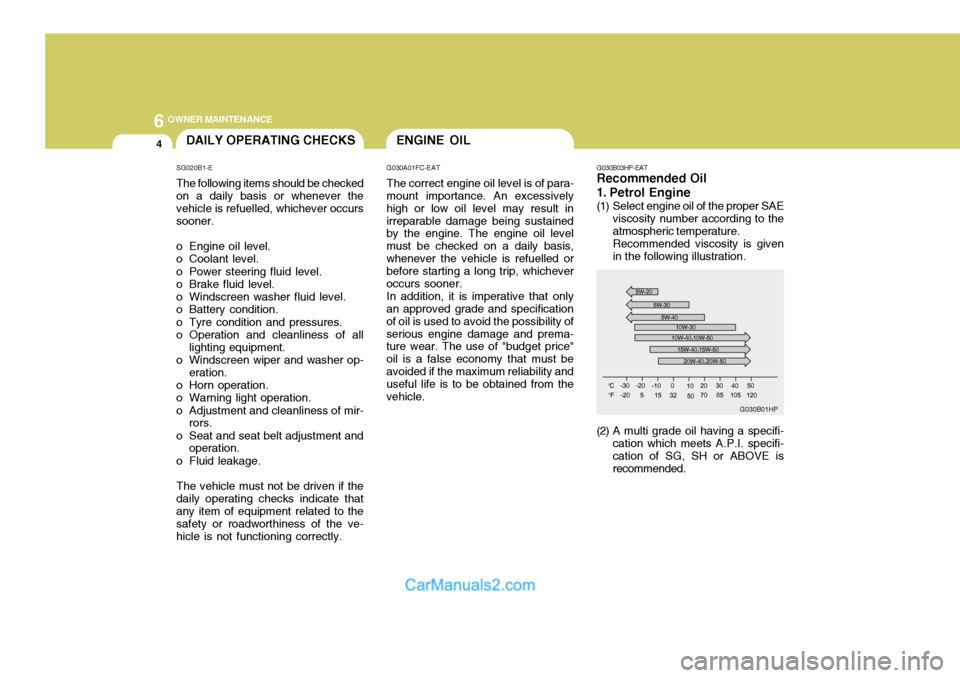
6 OWNER MAINTENANCE
4
G030B03HP-EAT
Recommended Oil
1. Petrol Engine
(1) Select engine oil of the proper SAE
viscosity number according to the atmospheric temperature.Recommended viscosity is givenin the following illustration.
(2) A multi grade oil having a specifi- cation which meets A.P.I. specifi-cation of SG, SH or ABOVE isrecommended.DAILY OPERATING CHECKS
SG020B1-E The following items should be checked on a daily basis or whenever the vehicle is refuelled, whichever occurssooner.
o Engine oil level.
o Coolant level.
o Power steering fluid level.
o Brake fluid level.
o Windscreen washer fluid level.
o Battery condition.
o Tyre condition and pressures.
o Operation and cleanliness of all lighting equipment.
o Windscreen wiper and washer op-
eration.
o Horn operation.
o Warning light operation.
o Adjustment and cleanliness of mir- rors.
o Seat and seat belt adjustment and operation.
o Fluid leakage. The vehicle must not be driven if the daily operating checks indicate that any item of equipment related to the safety or roadworthiness of the ve-hicle is not functioning correctly.ENGINE OIL
G030A01FC-EAT The correct engine oil level is of para-
mount importance. An excessively high or low oil level may result inirreparable damage being sustained by the engine. The engine oil level must be checked on a daily basis,whenever the vehicle is refuelled or before starting a long trip, whichever occurs sooner.
In addition, it is imperative that only
an approved grade and specificationof oil is used to avoid the possibility ofserious engine damage and prema- ture wear. The use of "budget price" oil is a false economy that must beavoided if the maximum reliability and useful life is to be obtained from the vehicle.
G030B01HP
Page 500 of 539
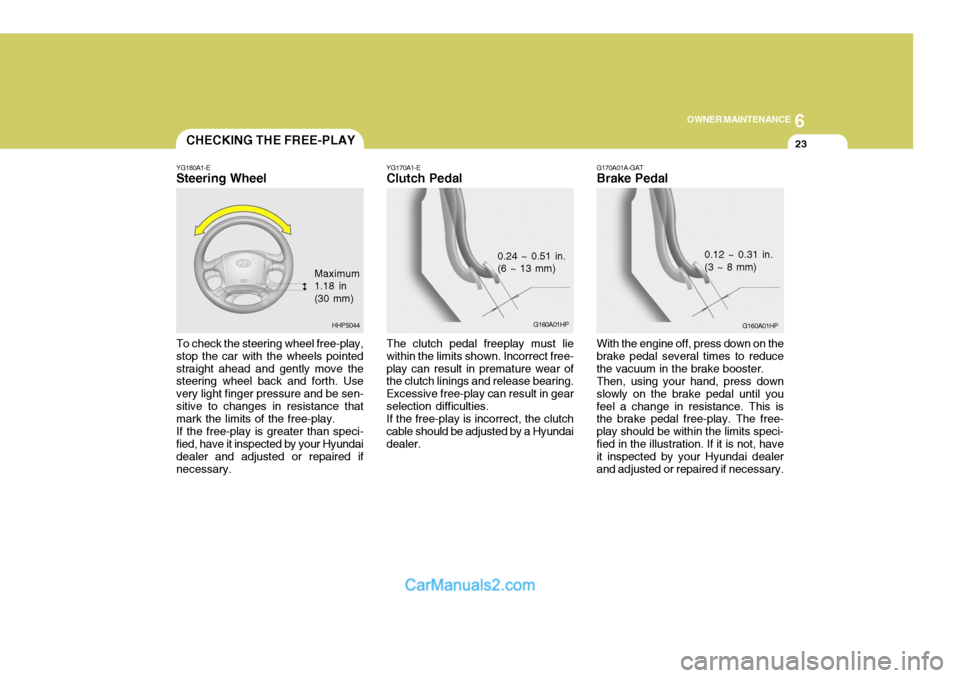
6
OWNER MAINTENANCE
23
To check the steering wheel free-play, stop the car with the wheels pointedstraight ahead and gently move the steering wheel back and forth. Use very light finger pressure and be sen-sitive to changes in resistance that mark the limits of the free-play. If the free-play is greater than speci- fied, have it inspected by your Hyundai dealer and adjusted or repaired if necessary. YG170A1-E
Clutch Pedal
The clutch pedal freeplay must lie
within the limits shown. Incorrect free-play can result in premature wear of the clutch linings and release bearing. Excessive free-play can result in gearselection difficulties. If the free-play is incorrect, the clutch
cable should be adjusted by a Hyundaidealer. G170A01A-GAT Brake Pedal With the engine off, press down on the brake pedal several times to reducethe vacuum in the brake booster.Then, using your hand, press downslowly on the brake pedal until youfeel a change in resistance. This is the brake pedal free-play. The free- play should be within the limits speci-fied in the illustration. If it is not, have it inspected by your Hyundai dealer and adjusted or repaired if necessary.CHECKING THE FREE-PLAY
YG180A1-E
Steering Wheel
Maximum 1.18 in(30 mm)
HHP5044
0.24 ~ 0.51 in. (6 ~ 13 mm)
G160A01HP0.12 ~ 0.31 in. (3 ~ 8 mm)
G160A01HP
Page 501 of 539
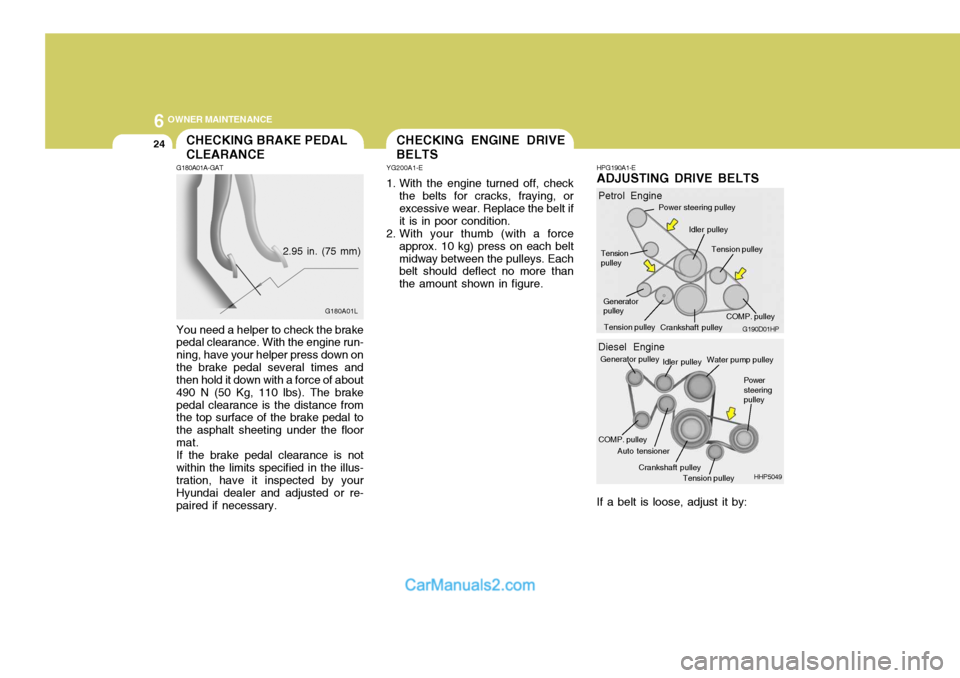
6 OWNER MAINTENANCE
24
You need a helper to check the brake pedal clearance. With the engine run- ning, have your helper press down onthe brake pedal several times and then hold it down with a force of about 490 N (50 Kg, 110 lbs). The brakepedal clearance is the distance from the top surface of the brake pedal to the asphalt sheeting under the floormat.If the brake pedal clearance is notwithin the limits specified in the illus- tration, have it inspected by your Hyundai dealer and adjusted or re-paired if necessary. HPG190A1-E
ADJUSTING DRIVE BELTS
If a belt is loose, adjust it by:CHECKING BRAKE PEDAL CLEARANCE
2.95 in. (75 mm) G180A01L
G190D01HP
Petrol Engine
Idler pulley
Power steering pulley
Crankshaft pulley
Generator pulley Tension pulley
Tension pulley
Tension pulley
COMP. pulley
HHP5049
Diesel Engine
Generator pulley
Tension pulley
COMP. pulley Power steeringpulley
Idler pulley
Auto tensioner Crankshaft pulley Water pump pulley
G180A01A-GAT
CHECKING ENGINE DRIVE BELTS
YG200A1-E
1. With the engine turned off, check the belts for cracks, fraying, or excessive wear. Replace the belt ifit is in poor condition.
2. With your thumb (with a force
approx. 10 kg) press on each beltmidway between the pulleys. Each belt should deflect no more than the amount shown in figure.
Page 506 of 539
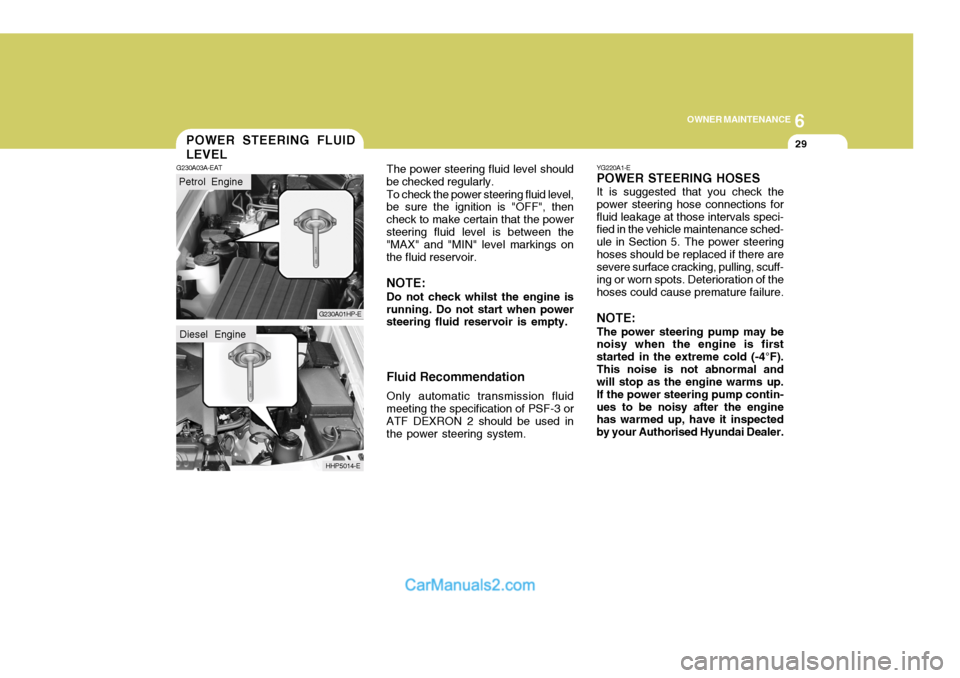
6
OWNER MAINTENANCE
29
YG220A1-E POWER STEERING HOSES It is suggested that you check the power steering hose connections forfluid leakage at those intervals speci- fied in the vehicle maintenance sched- ule in Section 5. The power steeringhoses should be replaced if there are severe surface cracking, pulling, scuff- ing or worn spots. Deterioration of thehoses could cause premature failure. NOTE: The power steering pump may be noisy when the engine is first started in the extreme cold (-4°F).This noise is not abnormal and will stop as the engine warms up. If the power steering pump contin-ues to be noisy after the engine has warmed up, have it inspected by your Authorised Hyundai Dealer.
The power steering fluid level should
be checked regularly.
To check the power steering fluid level,
be sure the ignition is "OFF", thencheck to make certain that the powersteering fluid level is between the "MAX" and "MIN" level markings on the fluid reservoir.
NOTE: Do not check whilst the engine is
running. Do not start when power steering fluid reservoir is empty. Fluid Recommendation
Only automatic transmission fluid meeting the specification of PSF-3 orATF DEXRON 2 should be used in the power steering system.POWER STEERING FLUID LEVEL
G230A03A-EAT
Petrol Engine
G230A01HP-E
HHP5014-E
Diesel Engine
Page 525 of 539
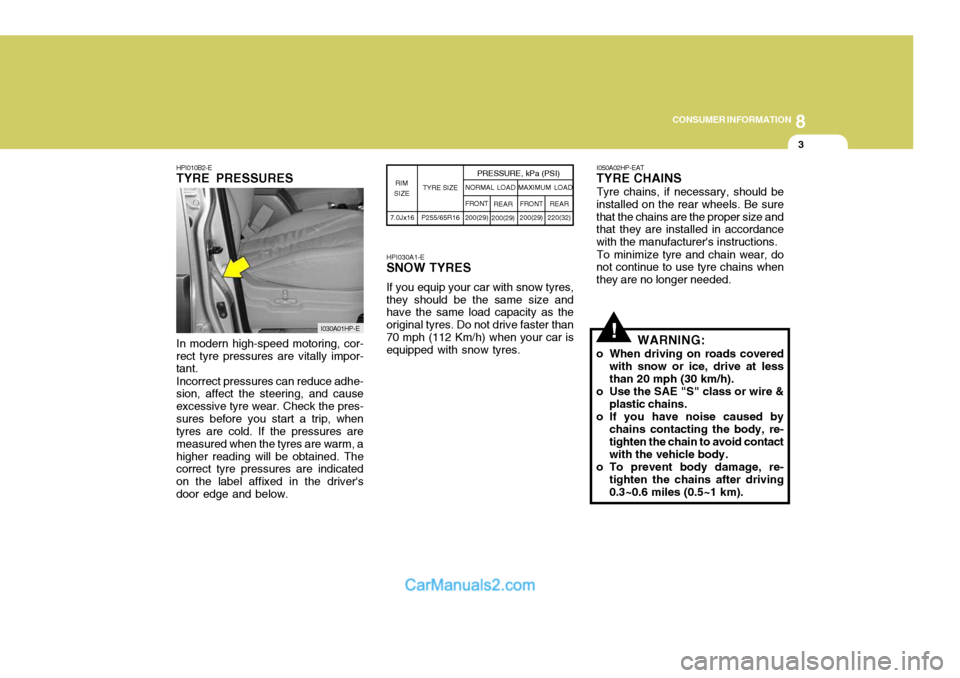
8
CONSUMER INFORMATION
3
!In modern high-speed motoring, cor-
rect tyre pressures are vitally impor- tant.
Incorrect pressures can reduce adhe-
sion, affect the steering, and cause excessive tyre wear. Check the pres-sures before you start a trip, when tyres are cold. If the pressures are measured when the tyres are warm, ahigher reading will be obtained. The correct tyre pressures are indicated on the label affixed in the driver'sdoor edge and below. HPI030A1-E SNOW TYRES If you equip your car with snow tyres, they should be the same size and have the same load capacity as the original tyres. Do not drive faster than70 mph (112 Km/h) when your car is equipped with snow tyres.
I050A02HP-EAT
TYRE CHAINS
Tyre chains, if necessary, should be
installed on the rear wheels. Be sure that the chains are the proper size and that they are installed in accordance with the manufacturer's instructions.
To minimize tyre and chain wear, do
not continue to use tyre chains whenthey are no longer needed.
WARNING:
o When driving on roads covered with snow or ice, drive at lessthan 20 mph (30 km/h).
o Use the SAE "S" class or wire &
plastic chains.
o If you have noise caused by chains contacting the body, re-tighten the chain to avoid contact with the vehicle body.
o To prevent body damage, re- tighten the chains after driving0.3~0.6 miles (0.5~1 km).
7.0Jx16
TYRE SIZE
RIM
SIZE PRESSURE, kPa (PSI)
P255/65R16 REAR
200(29) FRONT
200(29)
NORMAL LOAD MAXIMUM LOAD
REAR
220(32)
FRONT 200(29)
HPI010B2-E
TYRE PRESSURES
I030A01HP-E
Page 527 of 539
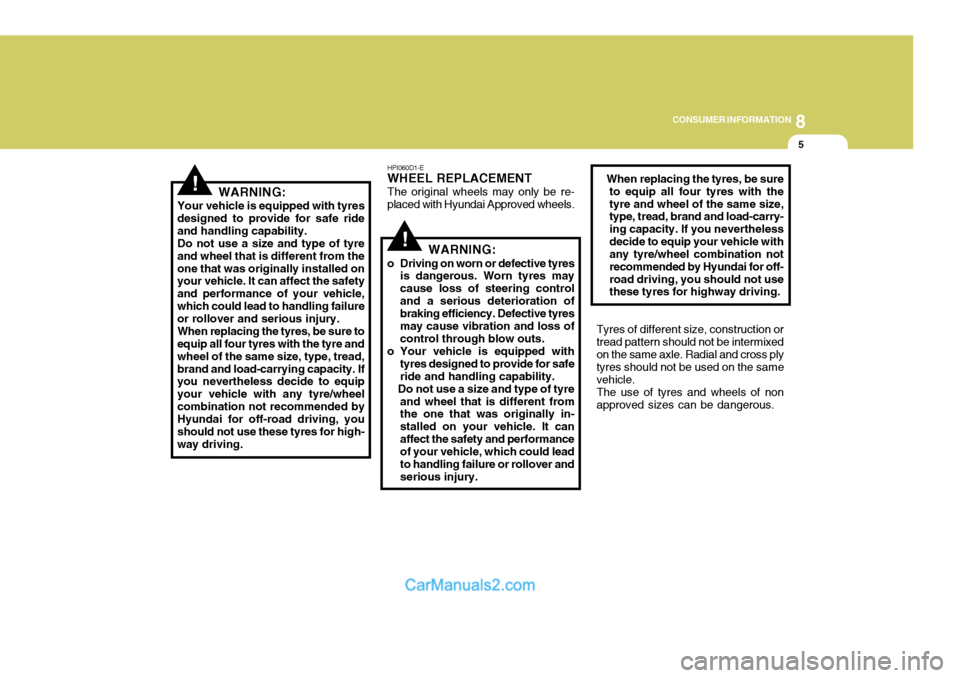
8
CONSUMER INFORMATION
5
!WARNING:
Your vehicle is equipped with tyres designed to provide for safe ride and handling capability.Do not use a size and type of tyreand wheel that is different from theone that was originally installed on your vehicle. It can affect the safety and performance of your vehicle,which could lead to handling failure or rollover and serious injury. When replacing the tyres, be sure to equip all four tyres with the tyre and wheel of the same size, type, tread,brand and load-carrying capacity. If you nevertheless decide to equip your vehicle with any tyre/wheelcombination not recommended by Hyundai for off-road driving, you should not use these tyres for high-way driving.
!
HPI060D1-E WHEEL REPLACEMENT The original wheels may only be re- placed with Hyundai Approved wheels.
WARNING:
o Driving on worn or defective tyres is dangerous. Worn tyres maycause loss of steering controland a serious deterioration of braking efficiency. Defective tyres may cause vibration and loss ofcontrol through blow outs.
o Your vehicle is equipped with
tyres designed to provide for saferide and handling capability.
Do not use a size and type of tyre and wheel that is different from the one that was originally in- stalled on your vehicle. It canaffect the safety and performance of your vehicle, which could lead to handling failure or rollover andserious injury.
When replacing the tyres, be sure
to equip all four tyres with the tyre and wheel of the same size, type, tread, brand and load-carry- ing capacity. If you neverthelessdecide to equip your vehicle with any tyre/wheel combination not recommended by Hyundai for off-road driving, you should not use these tyres for highway driving.
Tyres of different size, construction or tread pattern should not be intermixed on the same axle. Radial and cross ply tyres should not be used on the samevehicle.The use of tyres and wheels of nonapproved sizes can be dangerous.